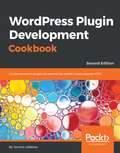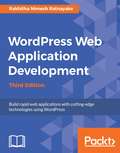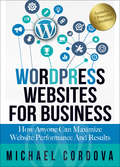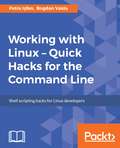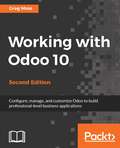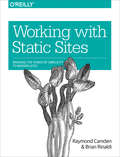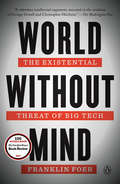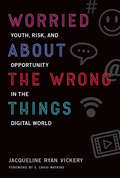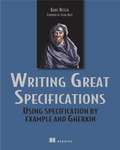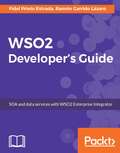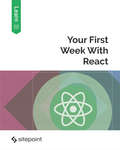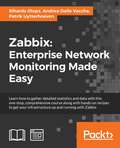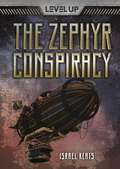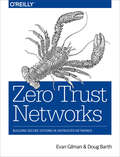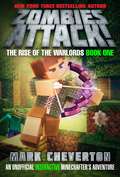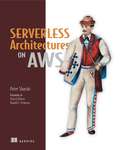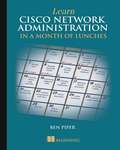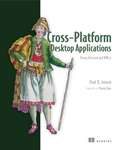- Table View
- List View
WordPress Plugin Development Cookbook - Second Edition
by Yannick LefebvreLearn to create plugins for WordPress 4.x to deliver custom projects or share with the community through detailed step-by-step recipes and code examples About This Book • Learn how to change and extend WordPress to perform virtually any task • Explore the plugin API through approachable examples and detailed explanations • Mold WordPress to your project's needs or transform it to benefit the entire community Who This Book Is For If you are a WordPress user, developer, or a site integrator with basic knowledge of PHP and an interest to create new plugins to address your personal needs, client needs, or share with the community, then this book is for you. What You Will Learn • Discover how to register user callbacks with WordPress, forming the basis of plugin creation • Explore the creation of administration pages and adding new content management sections through custom post types and custom database tables • Improve your plugins by customizing the post and page editors, categories and user profiles, and creating visitor-facing forms • Make your pages dynamic using Javascript, AJAX and adding new widgets to the platform • Learn how to add support for plugin translation and distribute your work to the WordPress community In Detail WordPress is a popular, powerful, and open Content Management System. Learning how to extend its capabilities allows you to unleash its full potential, whether you're an administrator trying to find the right extension, a developer with a great idea to enhance the platform for the community, or a website developer working to fulfill a client's needs. This book shows readers how to navigate WordPress' vast set of API functions to create high-quality plugins with easy-to-configure administration interfaces. With new recipes and materials updated for the latest versions of WordPress 4.x, this second edition teaches you how to create plugins of varying complexity ranging from a few lines of code to complex extensions that provide intricate new capabilities. You'll start by using the basic mechanisms provided in WordPress to create plugins and execute custom user code. You will then see how to design administration panels, enhance the post editor with custom fields, store custom data, and modify site behavior based on the value of custom fields. You'll safely incorporate dynamic elements on web pages using scripting languages, and build new widgets that users will be able to add to WordPress sidebars and widget areas. By the end of this book, you will be able to create WordPress plugins to perform any task you can imagine. Style and approach This cookbook will take you through the creation of your first simple plugin to adding entirely new sections and widgets in the administration interface, so you can learn how to change and extend WordPress to perform virtually any task. Each topic is illustrated through realistic examples showing how to solve common problems, followed by detailed explanations of all concepts used
Wordpress Web Application Development - Third Edition
by Rakhitha Nimesh RatnayakeLearn in easy stages how to rapidly build leading-edge web applications from scratch. About This Book • Develop powerful web applications rapidly with WordPress • Explore the significant features and improvements introduced in WordPress 4.7 by learning the numerous tips and techniques in this book. • Unleash the power of REST API endpoints to make your interaction with websites new and innovative. Who This Book Is For This book is targeted at WordPress developers and designers who want to develop quality web applications within a limited time frame and maximize their profits. A prior knowledge of basic web development and design is assumed. What You Will Learn • Develop extendable plugins with the use of WordPress features in core modules • Develop pluggable modules to extend the core features of WordPress as independent modules • Manage permissions for a wide range of content types in web applications based on different user types • Follow WordPress coding standards to develop reusable and maintainable code • Build and customize themes beyond conventional web layouts • Explore the power of core database tables and understand the limitations when designing database tables for large applications • Integrate open source modules into WordPress applications to keep up with the latest open source technologies • Customize the WordPress admin section and themes to create the look and feel of a typical web application In Detail WordPress is one of the most rapidly expanding markets on the Web. Learning how to build complex and scalable web applications will give you the ability and knowledge to step into the future of WordPress. WordPress 4.7 introduces some exciting new improvements and several bug fixes, which further improve the entire development process.This book is a practical, scenario-based guide to expanding the power of the WordPress core modules to develop modular and maintainable real-world applications from scratch. This book consistently emphasizes adapting WordPress features into web applications. It will walk you through the advanced usages of existing features such as access controlling; database handling; custom post types; pluggable plugins; content restrictions; routing; translation; caching; and many more, while you build the backend of a forum management application. This book begins by explaining how to plan the development of a web application using WordPress' core features. Once the core features are explained, you will learn how to build an application by extending them through custom plugin development. Finally, you will explore advanced non-functional features and application integration. After reading this book, you will have the ability to develop powerful web applications rapidly within limited time frames. Style and approach An extensive, practical guide that explains how to adapt WordPress features, both conventional and trending, for web applications.
Wordpress Websites for Business: How Anyone Can Maximize Website Performance and Results
by Michael CordovaA website development pioneer gives business owners—from tech savvy to beginner—the tools, knowledge, and tactics to succeed in today’s online economy.If your company is building a new website, you’re certainly thinking about content and design. But don’t forget performance, especially if you need your website to generate business leads and sales. Wordpress Websites for Business guides you through the process of building a website that will sustain and grow your company. Using the techniques detailed in this book I am currently bringing in more than one million dollars’ worth of leads a month for one of my clients.I have used most of the top content management systems and built many custom CMS systems myself. From my experience, I can say that Wordpress is the most effective tool available to build your company’s website and bring in leads and sales for your business. However, if used incorrectly, it can actually hurt your company. I’ve seen it happen, and the effects can be devastating. The good news is that there’s a better way. In an easy-to-follow, step-by-step program, this book will tell you what you need to do to avoid the pitfalls while ensuring maximum exposure, search engine rankings, and conversions (sales)!This powerful book features: game changing checklists and resources; simple settings that only take a few minutes, but can make a huge difference in website performance; the best Wordpress plugins and services to optimize your site and maximize leads; the best Wordpress themes that enable you to build an up-to-date website that performs for you; content creation hacks such as how to map your business goals directly to your content; Wordpress best practices simplified, such as why and how to create a child theme; the tools and techniques that drop your page load times to less than two seconds; and much more . . .The strategies and tactics I present in Wordpress Websites for Business will result in more leads and sales for your company, and that’s what it’s all about.
Working with Linux – Quick Hacks for the Command Line
by Bogdan Vaida Petru I FanSay goodbye to unproductive Linux habits and switch to the express lane About This Book • Improve your terminal and command-line productivity by using powerful tools • Sharpen your existing command-line skills and achieve complex tasks faster • Save time and money by creating customized commands that automate day-to-day tasks Who This Book Is For This book is for system administrators and developers who know the basics of Linux and want to brush up and sharpen their skills. Prior experience with Linux shell is required. What You Will Learn • Optimize the power of Guake by integrating it with ClipIt • Deep dive into the workings of the console editor—Vim • Explore the advanced concepts and best practices of shell scripting • Edit large amounts of data quickly using Sed • Use pipes and subshells to create customized commands • Get to know how you can speed up the software development and make the terminal a handy companion In Detail Websites, online services, databases, and pretty much every other computer that offers public services runs on Linux. From small servers to clusters, Linux is anywhere and everywhere. With such a broad usage, the demand for Linux specialists is ever growing. For the engineers out there, this means being able to develop, interconnect, and maintain Linux environments. This book will help you increase your terminal productivity by using Terminator, Guake and other tools. It will start by installing Ubuntu and will explore tools and techniques that will help you to achieve more work with less effort. Next, it will then focus on Terminator, the ultimate terminal, and vim, one of the most intelligent console editors. Futhermore, the readers will see how they can increase their command line productivity by using sed, find, tmux, network, autoenv. The readers will also see how they can edit files without leaving the terminal and use the screen space efficiently and copy-paste like a pro. Towards the end, we focus on network settings, Git hacks, and creating portable environments for development and production using Docker. Through this book, you will improve your terminal productivity by seeing how to use different tools. Style and Approach This book takes a step-by-step approach using examples that show you how to automate tasks using terminal commands. You'll work through easy-to-follow instructions so you learn to use the various Linux commands and tools such as Terminator, Guake, and others.
Working with Odoo 10 - Second Edition
by Greg MossConfigure, manage, and customize Odoo to build professional-level business applications About This Book • Build an Odoo module and integrate it with other platforms through this practical guide • This book is the perfect companion to help you customize your Odoo installations for your enterprise requirements • Use project management along with analytics for better reporting Who This Book Is For This book is for those who have not used Odoo before, allowing you to learn advanced-level features with Odoo such as creating your own custom modules. You do not need any knowledge of Odoo. What You Will Learn • Configure a functioning customer relationship management system • Set up a purchasing and receiving system • Implement manufacturing operations and processes using real-world examples • Discover the capabilities of Odoo's financial accounting and reporting features • Integrate powerful human resource applications • Utilize Odoo's project management application to organize tasks • Customize Odoo without writing a line a code In Detail Odoo is a comprehensive set of open-source enterprise management applications. Now with Odoo 10, you have access to a powerful website builder, integrated e-commerce features, and a fast-growing community to help transform and modernize your business. You will start with how to set up Odoo online and on your own server. You'll then configure the basic company settings required to quickly getting your first Odoo system up and running. Later you'll explore Customer Relationship Management in Odoo and and their importance in today's modern business environment. Next we will deep dive into purchasing application with Odoo and learn some of the primary functionalities of ERP systems for manufacturing operations. You will then use analytic accounting to provide better reporting. Finally you will walk through the recent Odoo 10 features with respect to the community and enterprise edition giving you complete understanding of what Odoo can do for you no matter the reason! Style and approach This fast-paced, step-by-step guide will show you everything you need to know about the Odoo module ecosystem through practical and real-world examples.
Working with Static Sites: Bringing the Power of Simplicity to Modern Sites
by Raymond Camden Brian RinaldiJust like vinyl LPs, static sites are making a comeback, evidenced by the wide array of static-site generators now available. This practical book shows you hands-on how to build these simple sites for blogs and other use cases, and how to make them more powerful. In the process, you’ll work with some of today’s more mature and popular static-site generators.Authors Raymond Camden and Brian Rinaldi explain the advantages of using static-site generators for building fast and secure sites. Web and frontend designers and developers will also explore methods for adding dynamic elements and for migrating an existing CMS to a static site.Build a basic four-page static site with the Harp generatorCreate a simple blog with JekyllDevelop a documentation site with Hugo by generating site files and creating the layoutAdd dynamic elements, such as forms, comments, and searchIntegrate a CMS with tools such as CloudCannon and Netlify CMSUse one of several options to deploy your static filesLearn methods for moving an existing CMS to a static site
World Without Mind: The Existential Threat of Big Tech
by Franklin FoerFranklin Foer reveals the existential threat posed by big tech, and in his brilliant polemic gives us the toolkit to fight their pervasive influence. Over the past few decades there has been a revolution in terms of who controls knowledge and information. This rapid change has imperiled the way we think. Without pausing to consider the cost, the world has rushed to embrace the products and services of four titanic corporations. We shop with Amazon; socialize on Facebook; turn to Apple for entertainment; and rely on Google for information. These firms sell their efficiency and purport to make the world a better place, but what they have done instead is to enable an intoxicating level of daily convenience. As these companies have expanded, marketing themselves as champions of individuality and pluralism, their algorithms have pressed us into conformity and laid waste to privacy. They have produced an unstable and narrow culture of misinformation, and put us on a path to a world without private contemplation, autonomous thought, or solitary introspection—a world without mind. In order to restore our inner lives, we must avoid being coopted by these gigantic companies, and understand the ideas that underpin their success. Elegantly tracing the intellectual history of computer science—from Descartes and the enlightenment to Alan Turing to Stuart Brand and the hippie origins of today's Silicon Valley—Foer exposes the dark underpinnings of our most idealistic dreams for technology. The corporate ambitions of Google, Facebook, Apple, and Amazon, he argues, are trampling longstanding liberal values, especially intellectual property and privacy. This is a nascent stage in the total automation and homogenization of social, political, and intellectual life. By reclaiming our private authority over how we intellectually engage with the world, we have the power to stem the tide. At stake is nothing less than who we are, and what we will become. There have been monopolists in the past but today's corporate giants have far more nefarious aims. They’re monopolists who want access to every facet of our identities and influence over every corner of our decision-making. Until now few have grasped the sheer scale of the threat. Foer explains not just the looming existential crisis but the imperative of resistance.
Worried About the Wrong Things: Youth, Risk, and Opportunity in the Digital World (The John D. and Catherine T. MacArthur Foundation Series on Digital Media and Learning)
by Jacqueline Ryan VickeryWhy media panics about online dangers overlook another urgent concern: creating equitable online opportunities for marginalized youth.It's a familiar narrative in both real life and fiction, from news reports to television storylines: a young person is bullied online, or targeted by an online predator, or exposed to sexually explicit content. The consequences are bleak; the young person is shunned, suicidal, psychologically ruined. In this book, Jacqueline Ryan Vickery argues that there are other urgent concerns about young people's online experiences besides porn, predators, and peers. We need to turn our attention to inequitable opportunities for participation in a digital culture. Technical and material obstacles prevent low-income and other marginalized young people from the positive, community-building, and creative experiences that are possible online.Vickery explains that cautionary tales about online risk have shaped the way we think about technology and youth. She analyzes the discourses of risk in popular culture, journalism, and policy, and finds that harm-driven expectations, based on a privileged perception of risk, enact control over technology. Opportunity-driven expectations, on the other hand, based on evidence and lived experience, produce discourses that acknowledge the practices and agency of young people rather than seeing them as passive victims who need to be protected.Vickery first addresses how the discourses of risk regulate and control technology, then turns to the online practices of youth at a low-income, minority-majority Texas high school. She considers the participation gap and the need for schools to teach digital literacies, privacy, and different online learning ecologies. Finally, she shows that opportunity-driven expectations can guide young people's online experiences in ways that balance protection and agency.
Writing Great Specifications: Using Specification by Example and Gherkin
by Kamil NiciejaSummaryWriting Great Specifications is an example-rich tutorial that teaches you how to write good Gherkin specification documents that take advantage of the benefits of specification by example. Foreword written by Gojko Adzic.Purchase of the print book includes a free eBook in PDF, Kindle, and ePub formats from Manning Publications.About the TechnologyThe clearest way to communicate a software specification is to provide examples of how it should work. Turning these story-based descriptions into a well-organized dev plan is another matter. Gherkin is a human-friendly, jargon-free language for documenting a suite of examples as an executable specification. It fosters efficient collaboration between business and dev teams, and it's an excellent foundation for the specification by example (SBE) process.About the BookWriting Great Specifications teaches you how to capture executable software designs in Gherkin following the SBE method. Written for both developers and non-technical team members, this practical book starts with collecting individual feature stories and organizing them into a full, testable spec. You'll learn to choose the best scenarios, write them in a way that anyone can understand, and ensure they can be easily updated by anyone.management. What's InsideReading and writing GherkinDesigning story-based test casesTeam CollaborationManaging a suite of Gherkin documentsAbout the ReaderPrimarily written for developers and architects, this book is accessible to any member of a software design team.About the AuthorKamil Nicieja is a seasoned engineer, architect, and project manager with deep expertise in Gherkin and SBE.Table of contentsIntroduction to specification by example and Gherkin PART 1 - WRITING EXECUTABLE SPECIFICATIONS WITH EXAMPLESThe specification layer and the automation layer Mastering the Given-When-Then template The basics of scenario outlines Choosing examples for scenario outlines The life cycle of executable specifications Living documentation PART 2 - MANAGING SPECIFICATION SUITES Organizing scenarios into a specification suite Refactoring features into abilities and business needs Building a domain-driven specification suite Managing large projects with bounded contexts
WSO2 Developer's Guide
by Fidel Prieto Estrada Ramon Garrido LazaroWSO2 Made Simple – dive deep into the core concepts of WSO2 to overcome the challenges faced while using the Enterprise Integrator About This Book • Design, create, and publish services in the WSO2 technology • Integrate the WSO2 Enterprise Integrator with other components and servers • Log and test deployed services Who This Book Is For If you are a Java solutions architect or developer and are keen to understand how to build enterprise applications with WSO2, this book is for you. No prior knowledge of WSO2 is expected. What You Will Learn • Configure WSO2 Enterprise Integrator server in a production environment • Create SOAP Proxies and REST APIs • Interact with WSO2 Message Broker • Write services using the new language: Ballerina • Schedule automatic tasks for the services you create • Manage log messages depending on the log level of the system • Integrate with social networks such as Twitter, Facebook, Instagram, and Yammer • Test SOAP Services using the Tryit feature and SoapUI tool • Work with Quality of Services In Detail WSO2 Enterprise Integrator brings together the most powerful servers provided by the WSO2 company for your SOA infrastructure. As an Enterprise Service Bus (ESB), WSO2 Enterprise Integrator provides greater flexibility and agility to meet growing enterprise demands, whereas, as a Data Services Server (DSS), it provides an easy-to-use platform for integrating data stores, creating composite views across different data sources, and hosting data services. Using real-world scenarios, this book helps you build a solid foundation in developing enterprise applications with powerful data integration capabilities using the WSO2 servers. The book gets you started by brushing up your knowledge about SOA architecture and how it can be implemented through WSO2. It will help build your expertise with the core concepts of ESB such as building proxies, sequences, endpoints, and how to work with these in WSO2. Going further, you will also get well-acquainted with DSS data service concepts such as configuring data services, tasks, events, testing, and much more. The book will also cover API management techniques. Along with ESB and DSS, you will also learn about business process servers, the rules server and other components that together provide the control and robustness your enterprise applications will need. With practical use cases, the book covers typical daily scenarios you will come across while using these servers to give you hands-on experience. Style and approach The book is a complete guide and helps you get the right start—from understanding SOA architectures to getting valuable experience with two important integration servers such as ESB and DSS. It will include some real-world practical scenarios to help you master the best practices followed right across the industry and overcome the challenges you're likely to face on a daily basis.
X-Machines for Agent-Based Modeling: FLAME Perspectives (Chapman & Hall/CRC Computer and Information Science Series)
by Mariam KiranFrom the Foreword: "This book exemplifies one of the most successful approaches to modeling and simulating [the] new generation of complex systems. FLAME was designed to make the building of large scale complex systems models straightforward and the simulation code that it generates is highly efficient and can be run on any modern technology. FLAME was the first such platform that ran efficiently on high performance parallel computers and a version for GPU technology is also available. At its heart, and the reason why it is so efficient and robust, is the use of a powerful computational model ‘Communicating X-machines’ which is general enough to cope with most types of modelling problems. As well as being increasingly important in academic research, FLAME is now being applied in industry in many different application areas. This book describes the basics of FLAME and is illustrated with numerous examples."—Professor Mike Holcombe, University of Sheffield, UK Agent-based models have shown applications in various fields such as biology, economics, and social science. Over the years, multiple agent-based modeling frameworks have been produced, allowing experts with non-computing background to easily write and simulate their models. However, most of these models are limited by the capability of the framework, the time it takes for a simulation to finish, or how to handle the massive amounts of data produced. FLAME (Flexible Large-scale Agent-based Modeling Environment) was produced and developed through the years to address these issues. This book contains a comprehensive summary of the field, covers the basics of FLAME, and shows how concepts of X-machines, can be stretched across multiple fields to produce agent models. It has been written with several audiences in mind. First, it is organized as a collection of models, with detailed descriptions of how models can be designed, especially for beginners. A number of theoretical aspects of software engineering and how they relate to agent-based models are discussed for students interested in software engineering and parallel computing. Finally, it is intended as a guide to developers from biology, economics, and social science, who want to explore how to write agent-based models for their research area. By working through the model examples provided, anyone should be able to design and build agent-based models and deploy them. With FLAME, they can easily increase the agent number and run models on parallel computers, in order to save on simulation complexity and waiting time for results. Because the field is so large and active, the book does not aim to cover all aspects of agent-based modeling and its research challenges. The models are presented to show researchers how they can build complex agent functions for their models. The book demonstrates the advantage of using agent-based models in simulation experiments, providing a case to move away from differential equations and build more reliable, close to real, models. The Open Access version of this book, available at https://doi.org/10.1201/9781315370729, has been made available under a Creative Commons Attribution-Non Commercial-No Derivatives 4.0 license.
You Started Your Blog: Now What...?
by Gundi Gabrielle<p>PLEASE NOTE: This book is written for COMPLETE BEGINNERS. <p>Those that have just set up their first blog and are now struggling with the next steps and where to go from here. It was written in response to feedback I received from my first book, which teaches the technical set up to complete beginners. I noticed patterns of what people were struggling with - often just even deciding what topic to focus on - and how blogging works in general. <p>This book will take you by the hand and guide you through the next steps - the solid, basic techniques that every successful blogger started with. There is no magic pill to suddenly attract thousands of followers - although there are a few techniques that can speed things up and we will cover them. Another area that is often underestimated is learning the WRITING STYLE OF BLOGGING, including how to format your posts.T his book goes into detail and provides resources for further training as that is obviously not something you will learn overnight. <p>We will also look at the characteristics of Viral blog posts, but - once again - don't expect a magic pill! Blogging is hard work and becoming a good blogger - a good blog writer - takes training and time, even if you are already experienced in writing. People read blogs differently than books and unless you adjust to that, you will have a hard time attracting an audience - no matter how experienced a writer you are. Finally, we wil go over the basic monetization strategies that are available to bloggers. <p>If you are new to blogging and are willing to put in the necessary work - and do so consistently - this book will give you a good basic start and take out much of the confusion new bloggers face. Of course, blogging also involves the powerful marketing techniques of SEO and Social Media and they are discussed in depth in part 3 and 4 of this series. I have personally found Kindle Publishing to be another great way to grow a blog following quickly - faster than any other technique actually - and so it is included as part 5 of this series. <p>Once again - if you are looking for advanced techniques, this book will not be for you - it is specifically aimed at beginners who have just started their first blog.</p>
Your First Week With React
by Maria Antonietta Perna Pavels Jelisejevs Michael Wanyoike Chris Laughlin Eric Greene Mark Brown Camilo ReyesReact is a remarkable JavaScript library that' taken the development community by storm. In a nutshell, it's made it easier for developers to build interactive user interfaces for web, mobile and desktop platforms. One of its best features is its freedom from the problematic bugs inherent in MVC frameworks, where inconsistent views is a recurring problem for big projects. Today, thousands of companies worldwide are using React, including big names such as Netflix and AirBnB. React has become immensely popular, such that a number of apps have been ported to React -- including WhatsApp, Instagram and Dropbox. This book is a collection of tutorials, selected from SitePoint's React Hub, that will guide you through your first days with the amazingly flexible library.
Your Office: Microsoft® Office 2016
by Amy Kinser Jacobson Kinser Kosharek MoriarityThe Your Office series prepares students to use both technical and soft skills in the real world. Hands-on technical content is woven into realistic business scenarios and focuses on using Microsoft Office® as a decision-making tool. The series features a unique running business scenario that connects all of the cases together and exposes students to using Office to solve problems relating to business areas like finance and accounting, production and operations, sales and marketing. p><p> Each chapter introduces a realistic business case for students to complete via hands-on steps that are easily identified in blue shaded boxes. Each blue box teaches a skill and comes complete with video and interactive support. Chapters are grouped into Business Units, which collectively illustrate a specific set of business concepts to achieve AACSB-related outcomes. Each Business Unit ends with a Capstone section, testing students' ability to apply concepts and skills beyond a single chapter.
Your Sh*tty Family: Real Texts. Crazy Relatives.
by Uninspirational“A hysterical new collection of text exchanges from moms, dads, grandparents, and siblings that prove, well, relatives are shitty to one another.” —BroBibleYour Sh*tty Family contains all the hilarity, confusion, and frustration of a visit home without the expensive plane tickets, the tiny twin bed, or any of the misery of actually having to spend time with your family. This book, based on the popular Instagram account of the same name, features actual text-message conversations between various family members. Your Sh*tty Family presents screenshots of these conversations that are relatable to anyone who has ever taught their parents to text. Topics range from hilarious misunderstandings of slang, to children who over-share, to siblings who mercilessly make fun of each other, all organized into outrageous categories such as Momster, Dadvice, Group Chats, and more!
Zabbix: Enterprise Network Montioring Made Easy
by Andrea Dalle Vacche Patrik Uytterhoeven Rihards OlupsLearn how to gather detailed statistics and data with this one-stop, comprehensive course along with hands-on recipes to get your infrastructure up and running with Zabbix. About This Book • Monitor your network and deploy impressive business solutions with Zabbix • Get practical recipes to automate your Zabbix infrastructure and create impressive graphs • Integrate, customize, and extend your monitoring solutions with external components and software. Who This Book Is For This course is for System Administrators who have been managing and monitoring infrastructure. You do not need any knowledge about Zabbix. What You Will Learn • Efficiently collect data from a large variety of monitoring objects • Organize your data in graphs, charts, maps, and slide shows • Write your own custom probes and monitoring scripts to extend Zabbix • Configure Zabbix and its database to be high available and fault-tolerant • Automate repetitive procedures using Zabbix's API • FInd out how to monitor SNMP devices • Manage hosts, users, and permissions while acting upon monitored conditions • Set up your Zabbix infrastructure efficiently • Customize the Zabbix interface to suit your system needs • Monitor your VMware infrastructure in a quick and easy way with Zabbix In Detail Nowadays, monitoring systems play a crucial role in any IT environment. They are extensively used to not only measure your system's performance, but also to forecast capacity issues. This is where Zabbix, one of the most popular monitoring solutions for networks and applications, comes into the picture. With an efficient monitoring system in place, you'll be able to foresee when your infrastructure runs under capacity and react accordingly. Due to the critical role a monitoring system plays, it is fundamental to implement it in the best way from its initial setup. This avoids misleading, confusing, or, even worse, false alarms that can disrupt an efficient and healthy IT department. This course is for administrators who are looking for an end-to-end monitoring solution. It will get you accustomed with the powerful monitoring solution, starting with installation and explaining the fundamentals of Zabbix. Moving on, we explore the complex functionalities of Zabbix in the form of enticing recipes. These recipes will help you to gain control of your infrastructure. You will be able to organize your data in the form of graphs and charts along with building intelligent triggers for monitoring your network proactively. Toward the end, you will gain expertise in monitoring your networks and applications using Zabbix. This Learning Path combines some of the best that Packt has to offer in one complete, curated package. It includes content from the following Packt products: • Zabbix Network Monitoring-Second Edition • Zabbix Cookbook • Mastering Zabbix-Second Edition Style and approach This course is a compact practical guide that starts from the fundamentals of Zabbix and takes you all the way to building a monitoring solution that gathers data from a large variety of systems. Along the way, we will discuss the low-level operational details that should benefit you even if you have used Zabbix for a while. It also follows a step-by-step approach that is easy to follow, full of engaging examples, and will help you apply the theory to practice.
The Zephyr Conspiracy (Level Up)
by Israel KeatsIn a virtual reality treasure hunt game, a gamer named Gadget is a steampunk pirate looking for her captain's lost treasure—a mysterious mechanical device. If she can find the scattered pieces that make up the device, she'll be released from the game. But the further she gets into it, the more Gadget worries she's in over her head. In a game where it's hard to know who's a real person and who's a non-player character, can Gadget trust anyone?
Zero Days, Thousands of Nights: The Life and Times of Zero-Day Vulnerabilities and Their Exploits
by Andy Bogart Lillian AblonZero-day vulnerabilities—software vulnerabilities for which no patch or fix has been publicly released—and their exploits are useful in cyber operations, as well as in defensive and academic settings. This report provides findings from real-world zero-day vulnerability and exploit data that can inform ongoing policy debates regarding stockpiling (i.e., keeping zero-day vulnerabilities private) versus disclosing them to the public.
Zero Trust Networks: Building Secure Systems in Untrusted Networks
by Doug Barth Evan GilmanThe perimeter defenses guarding your network perhaps are not as secure as you think. Hosts behind the firewall have no defenses of their own, so when a host in the "trusted" zone is breached, access to your data center is not far behind. That’s an all-too-familiar scenario today. With this practical book, you’ll learn the principles behind zero trust architecture, along with details necessary to implement it.The Zero Trust Model treats all hosts as if they’re internet-facing, and considers the entire network to be compromised and hostile. By taking this approach, you’ll focus on building strong authentication, authorization, and encryption throughout, while providing compartmentalized access and better operational agility.Understand how perimeter-based defenses have evolved to become the broken model we use todayExplore two case studies of zero trust in production networks on the client side (Google) and on the server side (PagerDuty)Get example configuration for open source tools that you can use to build a zero trust networkLearn how to migrate from a perimeter-based network to a zero trust network in production
Zombies Ate My Homework: An Unofficial Graphic Novel for Minecrafters (Redstone Junior High #1)
by Cara J. Stevens Fred BorcherdtThis story kicks off a new full-color series of unofficial graphic novels for Minecrafters! When quiet farm girl Pixel receives an acceptance letter from the prestigious academy for gifted students, Redstone Junior High, she is thrilled! And she works up the courage to leave her family and her beloved farm animals to become a Redstone student. The school prides itself on its safety record as much as its academics -- Mob-free for more than 100 years! boasts a sign on campus.Little does Pixel know that the school's long history of safety is about to take an unsettling turn. When zombies begin popping up on campus, the students begin to panic. Pixel, with the help of her new best friends, is the only one who can figure out why the zombies are invading -- but can she do it before the school becomes a battlefield?The adventure that unfolds will test Pixel's courage, reveal a unique and precious gift that she never knew she had, and change how she treats hostile mobs forever. <P><P> <i>Advisory: Bookshare has learned that this book offers only partial accessibility. We have kept it in the collection because it is useful for some of our members. Benetech is actively working on projects to improve accessibility issues such as these.</i>
Zombies Attack!: The Rise of the Warlords Book One: An Unofficial Interactive Minecrafter's Adventure (Rise of the Warlords #1)
by Mark ChevertonThe Far Lands is a hidden area located at the very edge of Minecraft’s outer borders, unknown to normal users. There, the life of a young boy named Watcher is suddenly turned upside down when his village is destroyed by the vile zombie warlord Tu-Kar. Watcher and a handful of his friends vow to save those who were captured during the devastating battle and bring the zombie leader to justice. But along the way, they’ll uncover a terrifying secret about the monsters in the Far Lands, one that could change Minecraft forever.The Rise of the Warlords series is an interactive Minecraft adventure like never before, giving fans the option to play along in Minecraft as they read on custom Far Lands worlds exclusively designed by bestselling author Mark Cheverton.
Serverless Architectures on AWS: With examples using AWS Lambda
by Peter Sbarski Sam KroonenburgSummaryServerless Architectures on AWS teaches you how to build, secure and manage serverless architectures that can power the most demanding web and mobile apps. Forewords by Patrick Debois (Founder of devopsdays) and Dr. Donald F. Ferguson (Columbia University).Purchase of the print book includes a free eBook in PDF, Kindle, and ePub formats from Manning Publications.About the TechnologyThere's a shift underway toward serverless cloud architectures. With the release of serverless computer technologies such as AWS Lambda, developers are now building entirely serverless platforms at scale. In these new architectures, traditional back-end servers are replaced with cloud functions acting as discrete single-purpose services. By composing and combining these serverless cloud functions together in a loose orchestration and adopting useful third-party services, developers can create powerful yet easy-to-understand applications.About the BookServerless Architectures on AWS teaches you how to build, secure, and manage serverless architectures that can power the most demanding web and mobile apps. You'll get going quickly with this book's ready-made real-world examples, code snippets, diagrams, and descriptions of architectures that can be readily applied. By the end, you'll be able to architect and build your own serverless applications on AWS.What's InsideFirst steps with serverless computingImportant patterns and architecturesWriting AWS Lambda functions and using the API GatewayComposing serverless applications using key services like Auth0 and FirebaseSecuring, deploying, and managing serverless architecturesAbout the ReaderThis book is for software developers interested in back end technologies. Experience with JavaScript (node.js) and AWS is useful but not required.About the AuthorDr. Peter Sbarski is a well-known AWS expert, VP of engineering at A Cloud Guru, and head of Serverlessconf.Table of ContentsPART 1 - FIRST STEPSGoing serverlessArchitectures and patternsBuilding a serverless applicationSetting up your cloudPART 2 - CORE IDEASAuthentication and authorizationLambda the orchestratorAPI GatewayPART 3 - GROWING YOUR ARCHITECTUREStorageDatabaseGoing the last mileAPPENDIXESServices for your serverless architectureInstallation and setupMore about authentication and authorizationLambda insiderModels and mapping
Learn Cisco Network Administration in a Month of Lunches
by Ben PiperSummaryLearn Cisco Network Administration in a Month of Lunches is a tutorial designed for beginners who want to learn how to administer Cisco switches and routers. Just set aside one hour a day (lunchtime would be perfect) for a month, and you'll start learning practical Cisco Network administration skills faster than you ever thought possible.Purchase of the print book includes a free eBook in PDF, Kindle, and ePub formats from Manning Publications.About the TechnologyCisco's ultrareliable routers and switches are the backbone of millions of networks, but "set and forget" is not an acceptable attitude. Fortunately, you don't have to be an old-time administrator to set up and maintain a Cisco-based network. With a handful of techniques, a little practice, and this book, you can keep your system in top shape.About the BookLearn Cisco Network Administration in a Month of Lunches is designed for occasional and full-time network administrators using Cisco hardware. In 22 bite-sized lessons, you'll learn practical techniques for setting up a Cisco network and making sure that it never fails. Real-world labs start with configuring your first switch and guide you through essential commands, protocols, dynamic routing tricks, and more. What's InsideUnderstand your Cisco network, including the difference between routers and switchesConfigure VLANs and VLAN trunksSecure your networkConnect and configure routers and switchesEstablish good maintenance habitsAbout the ReaderThis book is written for readers with no previous experience with Cisco networking. About the AuthorBen Piper is an IT consultant who holds numerous Cisco, Citrix, and Microsoft certifications including the Cisco CCNA and CCNP. He has created many video courses on networking, Cisco CCNP certification, Puppet, and Windows Server Administration.Table of ContentsBefore you beginWhat is a Cisco network?A crash course on Cisco's Internetwork Operating SystemManaging switch portsSecuring ports by using the Port Security featureManaging virtual LANs (VLANs)Breaking the VLAN barrier by using switched virtual interfacesIP address assignment by using Dynamic Host Configuration ProtocolSecuring the network by using IP access control listsConnecting switches using trunk linksAutomatically configuring VLANs using the VLAN Trunking ProtocolProtecting against bridging loops by using the Spanning Tree ProtocolOptimizing network performance by using port channelsMaking the network scalable by connecting routers and switches togetherManually directing traffic using the IP routing tableA dynamic routing protocols crash courseTracking down devicesSecuring Cisco devicesFacilitating troubleshooting using logging and debuggingRecovering from disasterPerformance and health checklistNext steps
Cross-Platform Desktop Applications: Using Node, Electron, and NW.js
by Paul JensenSummaryCross-Platform Desktop Applications guides you step-by-step through creating Node.js desktop applications with NW.js and Electron from GitHub. Foreword by Cheng Zhao, creator of Electron.Purchase of the print book includes a free eBook in PDF, Kindle, and ePub formats from Manning Publications.About the TechnologyDesktop application development has traditionally required high-level programming languages and specialized frameworks. With Electron and NW.js, you can apply your existing web dev skills to create desktop applications using only HTML, CSS, and JavaScript. And those applications will work across Windows, Mac, and Linux, radically reducing development and training time.About the BookCross-Platform Desktop Applications guides you step by step through the development of desktop applications using Electron and NW.js. This example-filled guide shows you how to create your own file explorer, and then steps through some of the APIs provided by the frameworks to work with the camera, access the clipboard, make a game with keyboard controls, and build a Twitter desktop notification tool. You'll then learn how to test your applications, and debug and package them as binaries for various OSs.What's InsideCreate a selfie app with the desktop cameraLearn how to test Electron apps with DevtronLearn how to use Node.js with your applicationAbout the ReaderWritten for developers familiar with HTML, CSS, and JavaScript.About the AuthorPaul Jensen works at Starcount and lives in London, UK.Table of ContentsPART 1 - WELCOME TO NODE.JS DESKTOP APPLICATION DEVELOPMENTIntroducing Electron and NW.jsLaying the foundation for your first desktop applicationBuilding your first desktop applicationShipping your first desktop applicationPART 2 - DIVING DEEPERUsing Node.js within NW.js and ElectronExploring NW.js and Electron's internalsPART 3 - MASTERING NODE.JS DESKTOP APPLICATION DEVELOPMENTControlling how your desktop app is displayedCreating tray applicationsCreating application and context menusDragging and dropping files and crafting the UIUsing a webcam in your applicationStoring app dataCopying and pasting contents from the clipboardBinding on keyboard shortcutsMaking desktop notificationsPART 4 - GETTING READY TO RELEASETesting desktop appsImproving app performance with debuggingPackaging the application for the wider world
掌握比特币-开始赚取比特币的指导: New Moon (Vampyre Ser.)
by Adidas Wilson 顺宏比特币是由名不副实的程序员或者一群程序员发明的一种加密货币和数字支付系统,名叫Satoshi Nakamoto。 它在2009年作为开源软件发布。 系统是点对点的,交易是直接在用户之间进行的,没有中间人。 这些交易由网络节点验证,并记录在称为区块链的公共分布式账本中。 由于该系统没有中央存储库或单个管理员,比特币被称为第一个分散数字货币。 比特币除了被创造为挖矿的奖励外,还可以在合法或黑市交换其他货币,产品和服务。 截至2015年2月,超过10万商户和供应商接受比特币作为付款。 根据剑桥大学2017年的研究报告,使用加密货币钱包的用户数量达到2.9-580万,其中大部分使用比特币。
